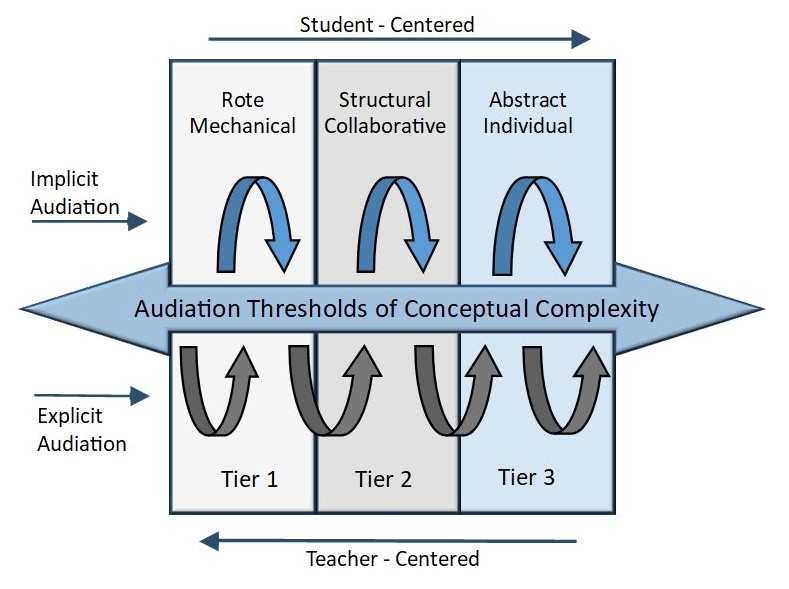
I almost stopped conducting. It was the first song for our first concert of the 2021 school year. My 9-12 Select Choir was singing Set Me As a Seal by René Clausen, and they struggled to lock in D major for the first few measures – it was a bit wonky. By the second phrase, the choir found the groove, locked in D major, and had a great concert. But my disappointment remained – what did I miss?
After the concert, I came up with several reasons why the choir stumbled. Maybe it was because (1) It was their first concert of the year, (2) they are a young choir, (3) they are relatively inexperienced (they did not sing much last year), or maybe (4) they did not hear the starting pitch given by one of our choir members who has perfect pitch.
As I look back on what happened that night, I have come up with a few more possibilities. Maybe they do not audiate the beginning of each song like I do. And if they didn’t, perhaps they were reacting to their singing after phonation and not before. Maybe they audiate very little, or even worst, not at all.
The Music Learning Theory (MLT)
Edwin Gordon defines audiation as “the ability to hear and give meaning to music when sound is not physically present or may never have been physically present” (Roots of Music Learning Theory and Audiation, p.10). To teach that skill is a tall order. Imagine if our choir members could obtain the ability to “hear and give meaning” to all their music-making both at school and at home. If so, we would always have incredible concerts, but most importantly, we would develop incredible young student musicians.
Music Learning Theory Links and Resources
Gordon, E. (2003), Learning Sequences in Music: Skill, Content, and Patterns: A Music Learning Theory.
Gordon, E. (2011), Roots of Music Learning Theory and Audiation, Chicago: GIA Publications.
AUDEA – A Journal for Research and Applications of Music Learning Theory
Ledbetter, J. (2016), Audiation in The Secondary Choral Ensemble: A Look at Music Learning Theory
Bluestine, E. (2000). The Ways Children Learn Music: An Introduction and Practical Guide to Music Learning Theory. Chicago, IL: GIA Publications.
Developing Audiation in the Choral Classroom
To help all my students grow musically and learn how to apply audiation to their music-making, I identified the following three tiers of audiation acquisition for the rehearsal setting. Each tier contains explicit audiation skills that must be purposefully experienced, developed, and internalized in order to move forward.
Through the internalization of each tier skills, students can cross conceptual thresholds in which their new understandings become implicit and their audiation conceptual complexity increases. “A threshold concept can be considered as akin to a portal, opening up a new and previously inaccessible way of thinking about something. It represents a transformed way of understanding, or interpreting, or viewing something without which the learner cannot progress.” (Land and Meyer, 2003, p. 3, emphasis mine)
The Three Tiers of Audiation Instruction
Tier 1, Rote and Mechanical Audiation
In Tier 1, students study foundational music literacy and the Music Learning Theory (MLT) audiation skills and vocabulary through rote teaching and discovery. For Tier 1, think K – 6 general music teaching standards.
Tier 1 Tonal Skill – Sing the resting tone/tonic of a short melody or phrase in various tonalities.
Tier 2, Structural and Collaborative Audiation
For Tier 2, students apply and expand their MLT audiation skills through purposeful instruction that focuses on collaboration and conceptual discovery and recognition. Tier 2 is where students show the most growth as they learn to transform explicit audiation to implicit understanding. This is also the tier where we spend the majority of our time teaching.
Tier 2 Tonal Skill – Audiate the resting tone/tonic for a melody or phrase in various tonalities.
Tier 3, Abstract Individual Audiation
In Tier 3, students continue to practice and internalize foundational, structural, and abstract MLT audiation through explicit and implicit learning. Tier 3 is extremely challenging. If we are not careful, we may pull or carry our students through audiation threshold concepts and deny them the opportunity to develop their audiation skills. In order to audiate, our students must learn that it is through trial and error that we learn and succeed. (That is how we made it through our undergrad and grad studies)
Tier 3 Tonal Skill – The audiation of a resting tone/tonic becomes implicit in all tonalities.
Audiation Instruction and Student Awareness
The strength of Three Tier Audiation Instruction lies in the fact that students become aware that they are constantly working towards a Tier Three understanding of music learning and audiation during rehearsals. When my ensembles stumble on a challenging song or concept, I tell them that we will shift to Tier 1intervention strategies for a bit and work our way back towards our goal of Tier 3.
I find that the choirs don’t mind reviewing basic music literacy skills. It is an excellent way of engaging and challenging all students. My students also know not to give their power away by waiting for the choir or me before they can individually practice a skill in a higher tier. So if we are working on a tier 2 skill and they can apply their own Tier 3 skill to the activity or exercise, they are encouraged to move ahead on their own. They are expected to take the initiative.
Teaching Strategies to Promote Audiation
The following are just a few effective teaching strategies that directors can use to help their ensembles discover, develop, and refine their audiation skills.
Every Other – (A label my students created using Mitchell (2007, p 48) strategies for audition)
1. Only sing the first and last note of each phrase – audiate the other notes in silence.
2. Alternate beats singing and audiating silently.
3. Sing for one measure, and then audiate for one measure.
Four-Step Process to Experience Audiation
1. Listen to the exercise/phrase, show the melodic contour, and “audiate with your hand.”
2. Sing the resting tone/tonic/” Do” on the first beat of each measure.
3. Sing only the first pitch of each measure. 4. Babble the phrase, and then solfege or sing the text.
Teaching a New Exercise (Mitchell, 2007, p 42-43)
1. Director demonstrates
2. Ask students to audiate the exercise in silence
3. Identify essential and non-essential pitches (think Schenkerian Analysis)
4. Students perform the full exercise
The Gordan Scale – My students gave this label to Gordon’s strategy on establishing tonal context. Major – so la so fa mi re ti di minor – mi fa mi re do ti so(si) la
Tier 1 – Babble the Gordon Scale
Tier 2 – Solfege Gordon Scale
Tier 3 – The Gordon Scale becomes implicit
Chaining – Break down tonal or rhythmic pattern by measures or into short 2-4 beat “links.” Then chain together the segments creating the complete phrase. Example: Sing link 1, audiate link 2, sing link 3, etc.
Stop-n-Lock
1. Sing each pitch void of any pulse.
2. Audiate each pitch showing melodic contour void of any pulse (with and without piano)
3. Initiate “every other” audition.
Shaw Chord or Whole-Tone Cluster (D, E, F#, and G#). My students prefer 4ths – C, F, B flat, and E flat. For SATB ensembles, sing the rhythm of their phrase on one specific pitch. Add audiation teaching strategies.
Pivot System (Vacca, 2013, p. 28). – The ability to sing and audiate a specific pitch and its function (1, 3, or 5) as it relates to the other pitches within a root position triad or seventh chord. For this Tier 3 Skill, Audiate C as the root in C major triad, Audiate C as the third in A flat major triad, and Audiate C as the fifth in F major triad.
TL:DR – Teaching Audiation in the Choral Classroom
Learning and attaining skills in audiation is both rewarding and demanding. It can be exhilarating and relieving as a new conceptual understanding opens previously inaccessible and advanced ways of thinking and performing. It is the “aha” or eureka moment we experience with our students as they gain insight into a challenging skill or concept as they cross a threshold from their previous skills to new and transformed understanding.
The strength of Three Tier Audiation Instruction lies in the fact that students learn to become aware of and responsive to their own audiation and musical skills. Teachers cannot give students the ability to audiate – audiation must be earned. Through purposeful trial and error, students can extend their understanding and ability to think for themselves and think musically. We must provide
Postlude
Our track and field coach recently discovered the SHEMA97 Functional Active Mask by HelmetFitting.com. A few of my choir members use them during rehearsals and love them. They are light, you do not suck in the mask every time you breathe, and best of all, they have excellent sound transmission. I now teach and sing with one every day. They are a must try!
Resources
Gordon, E, E. (2021). Learning Sequences in Music: A Contemporary Music Learning Theory, Chicago, Il. GIA Publications, Inc.
Hicks, Charles E. “Sound before Sight Strategies for Teaching Music Reading.” Music Educators Journal 66, no. 8 (1980): 53–67. https://doi.org/10.2307/3395858.
Liperote, K. A. (2006). Audiation for Beginning Instrumentalists: Listen, Speak, Read, Write. Music Educators Journal 93(1) DOI: 10.2307/3693430
Mitchell, C. A. 2007, Audiation and the Study of Singing. FSU Digital Library
Meyer, J., and Land, R., (2003) Threshold Concepts and Troublesome Knowledge: Linkages to Ways of Thinking and Practicing. (available at www.etl.tla.ed.ac.uk/docs/ETLreport4.pdf)
Saunders, T. C. (1991). The Stages of Music Audiation: A survey of research. The Quarterly, 2(1C2), pp. 131C137.(Reprinted with permission in Visions of Research in Music Education, 16(2), Autumn, 2010). Retrieved from http://wwwCusr.rider.edu/~vrme
Trusheim, W. H. (1991) Audiation and Mental Imagery: Implications for Artistic Performance. The Quarterly, 2 (1-2), 138-147
Vacca, S. (2013), Developing Audiation Through Internalisation: using the pivots system as an example.https://ro.ecu.edu.au/theses_hons/94




Chris Munce says
Yes! It’s great to see process content. So rare, and so needed. Audiation is the future!